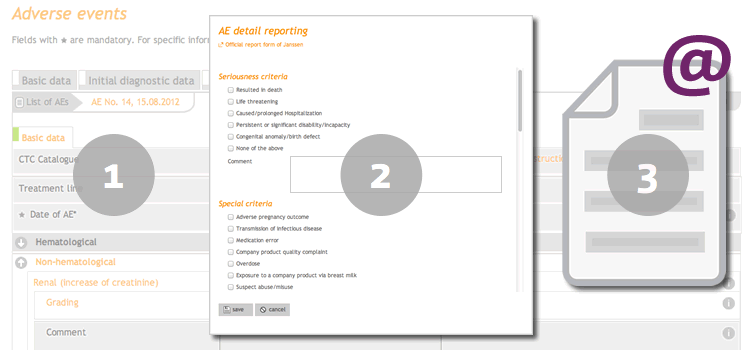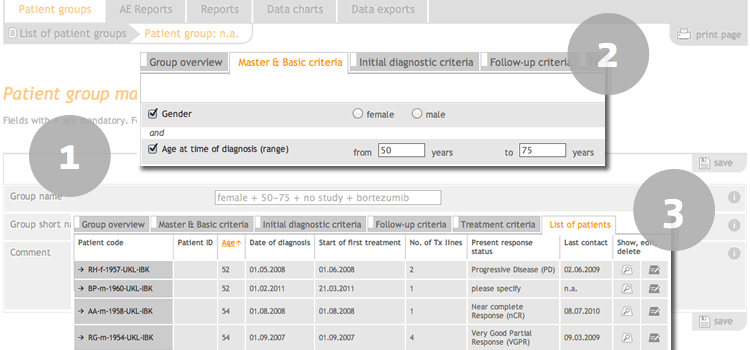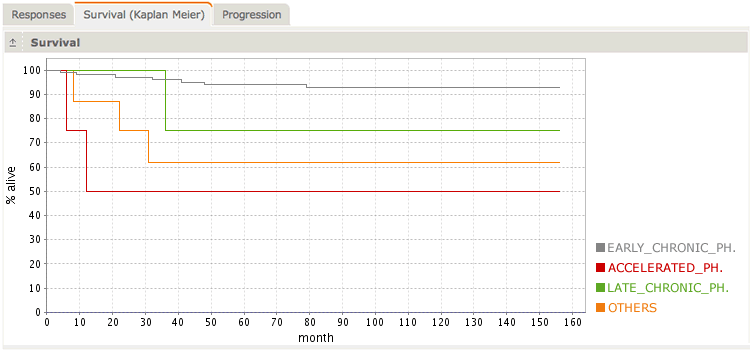Our Solution
Overview
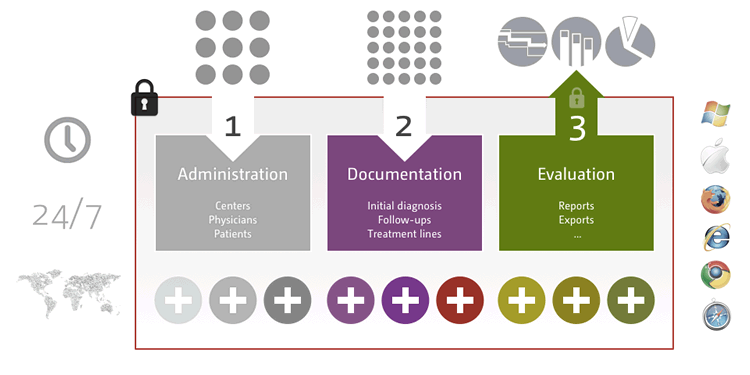
The aim of our patient registries is always to make the quality of medical care transparent using the collected data and to optimize this. Not only do they record epidemiological data, but also detailed information about the progress of diseases, treatments and their side effects. The web-based solution makes this possible in real time, thereby providing participating physicians with a direct, additional benefit. Furthermore, the sponsors profit from the high availability of post-marketing information about the effectiveness and side effects of approved medication from their use in practice.
Registry access
Access to the patient registry is mostly organized around centers and controlled using roles. Every physician in a center can access all the data of patients being treated, but not the data of other centers. More specific access controls exist for registries in which more than one field or center is involved per patient.
In every case the focus is on the patient and their data on diagnosis, treatment and follow-up treatment, ensuring that the progress of their illness is observed in its entirety. After having received their own personal login details, physicians can begin collecting data immediately, provided that the responsible ethics commission has agreed and the patients given their consent.
Inputting and importing data
Data are collected via an intuitive user interface. Accurate online support and automatic plausibility checks safeguard data quality regardless of whether the data are entered by physicians or by trained personnel such as study nurses. If required, we can even assume the task of inputting data as an additional service. It is also possible to import data manually or automatically, provided that appropriate structural and technical requirements have been settled and a corresponding expansion module has been implemented.
Analyzing data
Every participant can perform a real-time analysis of their data in the patient registry, provided that the corresponding analysis modules have been implemented. Alternatively, the data can be exported and analyzed using an external system such as SPSS or Excel.
Technical requirements
The patient registries work with all browsers and on any operating system. Local installation, specific infrastructure or special technical training is not required. We recommend using an up-to-date internet browser – but older browser generations are also supported. This helps to avoid any potential obstacles to an electronic registry.
Basic system and add-ons
The patient registry solution is flexible and can be scaled as desired. The system we use as a basis contains essential core modules and core functions. A number of specific add-on modules are then available and which we currently use in several patient registries. We are also able to accommodate individual requirements and integrate these into our existing solution.
Basic system
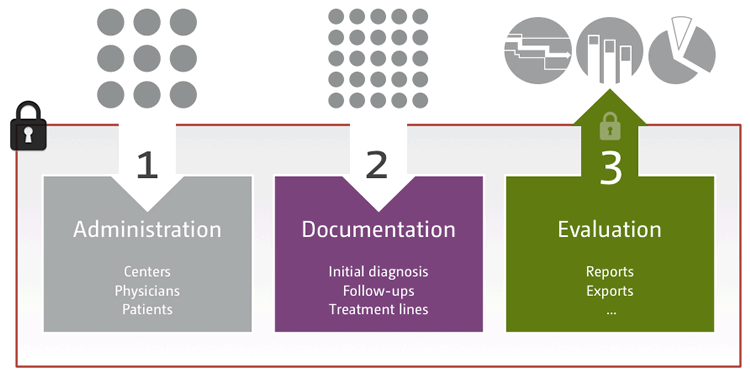
The basic structure that has proven to be the most effective is the one in which the solution is divided into three modules: Administration, Documentation and Evaluation. This forms the structural backbone of our solution.
The Administration module captures all master data: participating centers, physicians and study nurses of these centers (each with individual master data and logins with their authorizations) and patients of these centers, also with their master data. An optional extension here could be to record countries or other structurally relevant units and link these to the rest of the data.
In the Documentation module, the following information is recorded for each patient: basic diagnostic data, detailed diagnostic data, data from follow-up examinations and treatment data. All records can be related to each other in terms of time, whereby lines of treatment or treatment-free periods can be displayed. The amount of detail to be included here can be flexibly selected. For instance, in an oncological registry, the simplest approach is just to record if chemotherapy has been used, while an alternative is to document every substance used in a treatment with dosages and exact treatment cycles.
In the Evaluation module, the collected data can be presented in easy-to-read reports and exported at any time. As with every other patient registry module, users can only access, edit and export data for which they have authorization. This means that, for instance, a center physician can access and export all of the patient data of this center. However, he has no access to patient data from other centers. Only users with higher-level authorization, e.g. a registry coordinator, can access, edit and export data from any center.
User interface and features
The user interface is simple, clearly laid out and attractively designed to enable users to work in pleasant environment without making any mistakes. Input forms are kept as simple as possible by displaying only the elements that are really needed. This means that data fields to record detailed diagnostic data are only shown once it has been stated that the examination required for these data has been performed.
Lists
In addition to master data such as patient codes and patient ages, lists such as patient lists also show current, relevant data including the date of the last recorded examination or the best response in the current line of treatment.
Info box and quick navigation
A folding box is a fixed element on every page that can be assigned to a single patient and contains the most important data and information concerning this patient. Quick navigation is also a fixed element, enabling access to the most important functions such as recording a new line of treatment. Additionally, a message board is located on the home page to serve as a communication tool between registry users.
Data quality
When inputting data, progress can be saved at any time. The entered data can be validated per field. Feedback (e.g. value outside plausibility limits) is provided immediately and directly next to the input field. Furthermore, information can be displayed (e.g. permissible values and plausibility limits). This additional information can be directly entered per data field by registry administrators and also be modified as required at any time.
Add-ons
The extension modules add additional features to the basic system.
The area of administration can be extended to include additional structural levels (countries, groups of centers or project groups) and an alternative authorization system.
The area of documentation can be extended to include a follow-up timeline with a reminder feature, an extended pharmacovigilance module with real-time reporting or perhaps a charting module for individual diagnostic parameters. Extensions to the area of data collection may include giving patients the opportunity to collect their own quality of life data. It is also possible to include a data import module or to establish a link to other databases.
The area of evaluation can be extended to include a module to create patient groups with flexible criteria for inclusion or exclusion. The online reporting function can be extended significantly and the export of data can be modified to meet additional requirements. An online charting feature (e.g. for survival curves, response or progression graphs, etc.) can be integrated.
Quality and security
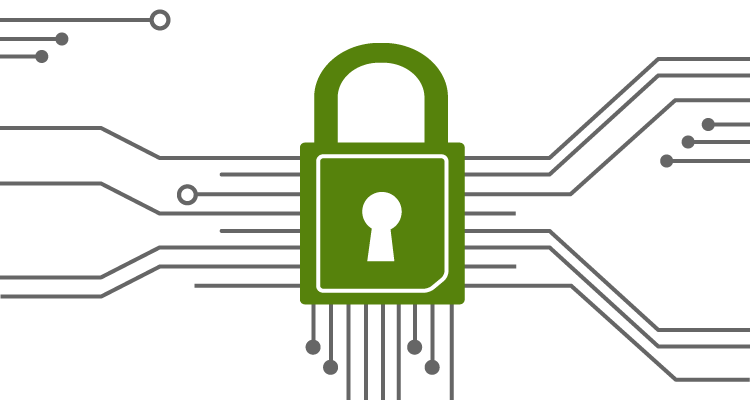
Quality assurance
Quality assurance in the field of healthcare is growing in importance. The reasons for this include the increasing complexity of modern diagnostics and treatment, the international recognition and prevalence of evidence-based treatment guidelines and the rising interest of patients, physicians and insurance companies in the transparency of services and healthcare results.
Efficient clinical registers represent a quality assurance instrument. They serve to implement and evaluate guidelines and their effectiveness in regional, national or multinational patient populations, to record side effects in large patient groups outside of clinical studies and pharmacoeconomic analyses under real-life conditions.
Data security
In addition, data security is one of the key issues with registry projects. Participating physicians are identified by means of a username and password – there is also the option to use additional codes in a similar way to online banking. All data are stored on fail-safe servers in the computer centers of Oesterreichische Kontrollbank AG (OeKB), which are protected against unauthorized accessed by state-of-the-art security systems. High availability (24/7) and regular back-ups are a matter of course for us. An additional benefit: OeKB is an independent partner and is committed to the highest standards of quality and security in its position as Austria’s number one financial and information services provider for exports and capital markets.
Both the Java application and the Oracle database offer high standards of security without compromising on flexibility and availability. Patient data are pseudonymized and stored in the online registry. When being exported, data is encrypted further and made available in an anonymized but statistically useful format.
Clinical online registries almost always lead to the introduction and monitoring of quality standards due to the required standardization of data collection. Furthermore, data from clinical registries show the extent to which evidence-based guidelines can be implemented in practice and if treatment results or toxicities differ noticeably from those observed in studies.
All of these quality and security aspects can create favorable conditions for a positive ethics vote. Our registries have been assessed by the respective ethics commissions and received positive results in every case.
Pharmacoeconomy and pharmacovigilance
Pharmacoeconomic assumptions can also be assessed with online registries on the basis of valid data. This aspect is key to obtaining reimbursement, as both the health insurer and the pharmaceutical industry receive data on cost effectiveness. In the medium term, online registries will lead to improved, evidence-based access to pharmacoeconomic data.
Online registries also represent the most efficient tool to perform pharmacovigilance and post-marketing surveillance effectively and thereby meet regulatory requirements. Only with complete records is it possible to document and analyses undesired effects and their possible link to risk factors (e.g. co-medication), ultimately lowering the risk for all patients.
Technology
Only reliable, state-of-the-art technologies for web-based applications are used for our patient registries.
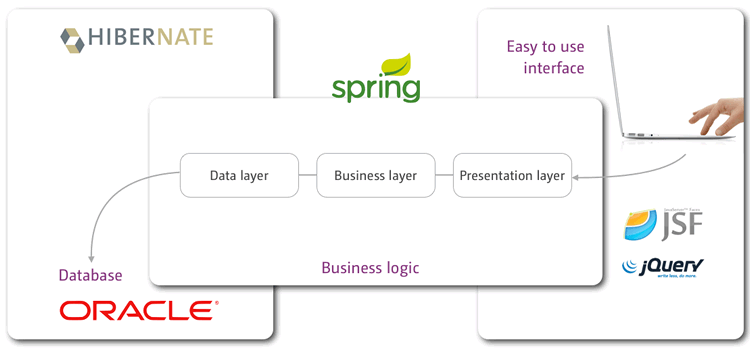
The program code was created using Java. The graphical user interface was developed with Java Server Faces. The framework Hibernate is used as an interface between application and database, ensuring optimum communication between programs and databases. Commercial database software produced by Oracle guarantees the highest level of database quality and reliability.
Cutting edge virtualization technology enables high performance and rapid reaction times in all patient registries, as every registry always gets the very hardware resources it needs to function properly.
All-round data security is guaranteed by modern data storage and archiving systems, which ensure redundant data storage and regular back-ups. The risk of data being lost is therefore practically zero.

